Category Archive for Art + Design
Cuba vintage car tour with Havana Urban Adventures! Renting a classic convertible, Callejon de Hamel Santeria.

When you think of Havana, Cuba — do classic cars come to mind? These sleek, 1950s-era automobiles are the only rides on the road in this fascinating country, where time seems to have frozen.
My dream was to ride down the Malecon in a vintage convertible… and this came true thanks to Havana Urban Adventures!

Urban Adventures offers one-of-a-kind, offbeat experiences in cities worldwide. These aren’t your typical tours; they’re small group or private adventures that let you dive deep into local life.
Read on to see how I cruised through Havana in this slick red “almendrón” (the Cuban word for antique auto)…

… and learned about Santeria (the Afro-Cuban religion of divine spirits), at the art-filled Callejon de Hamel.
(Photography by Asta Mail and me.)
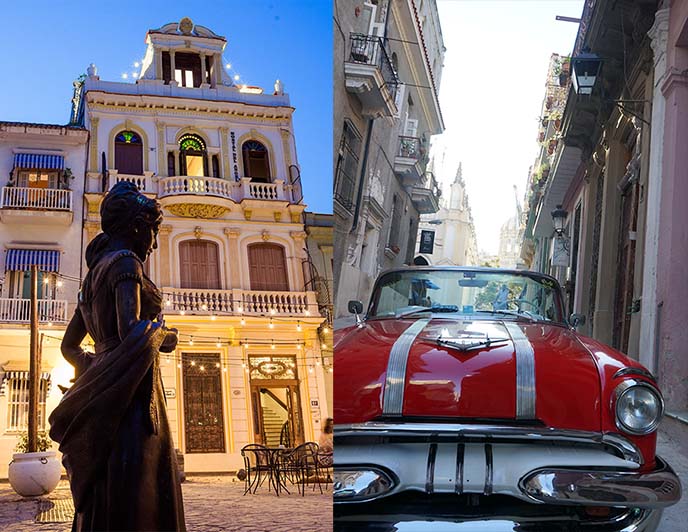
In my first post about Cuba, I wrote about the joy of staying in a “casa particular” (Prado Colonial) and supporting local businesses. (You can read the full review here; definitely reach out if you’re looking for an authentic place to stay in Old Havana.)
When we made a booking with Urban Adventures, we received vouchers with confirmations of the start time, location, contact details and other info. In our case, the classic car came straight to our front door to pick us up for the 2 hour ride.

“Best day ever” is accurate, when it comes to their tours. As you may recall, I also linked up with Urban Adventures in Athens and Bucharest. I’m impressed by how their guides are always full of passion for their hometowns. In this case, Armando (Mandy) greeted us with a smile, and whisked us off on an adventure.
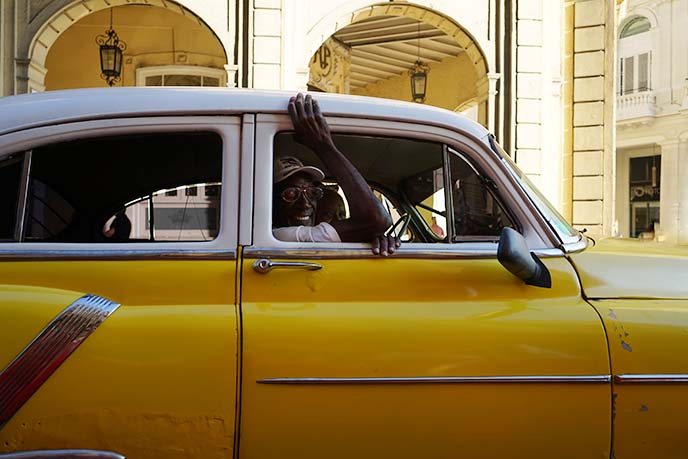
While the driver navigated, Mandy filled us in on the colorful sights around us. We rode through Habana Viejo and Miramar, where we glimpsed colonial architecture, monuments, and the glamorous Fifth Avenue. Such a joy to ride through these streets in an antique car, and soak it all in.

Our first stop: Plaza de la Revolución, or Revolution Square.
Behind me, you can see a memorial to Camilo Cienfuegos, one of the four leaders of the Cuban Revolution (along with Fidel Castro, Raul Castro and Che Guevara). Manny explained that “Vas bien, Fidel” (You’re doing fine) refers to the supportive comment he made to the leader during his speech to the people.
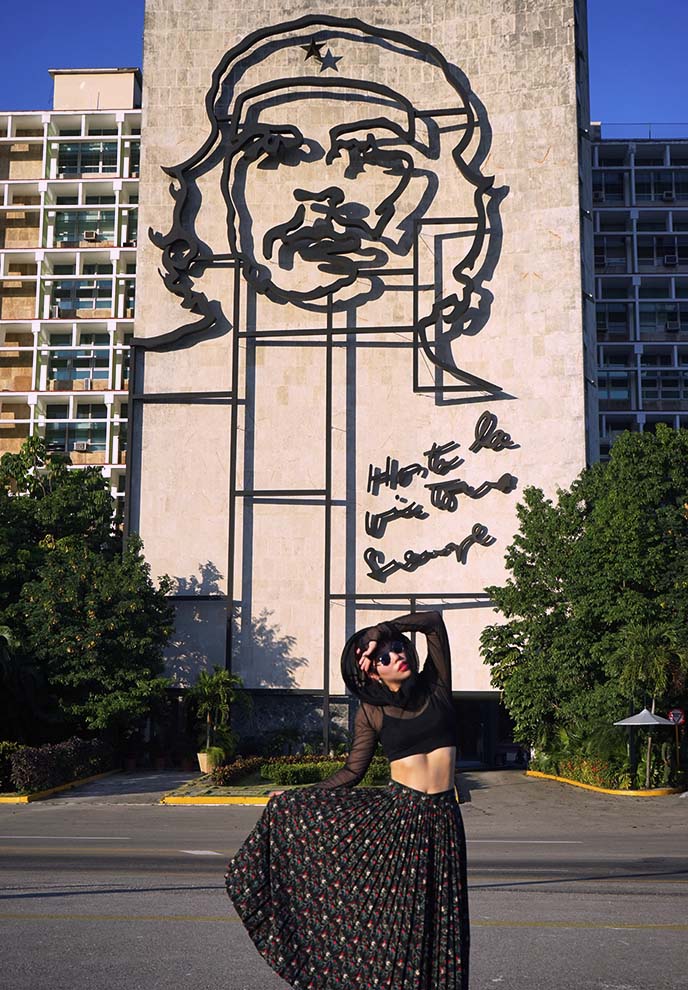
Next to him is this iconic counterculture portrait. I’m sure you recognize the face of Che Guevara, the guerrilla revolutionary! Che’s slogan, “hasta la victoria siempre” (Until victory always), exemplifies how he always strove to the fullest in his quest to help the people of Latin America.
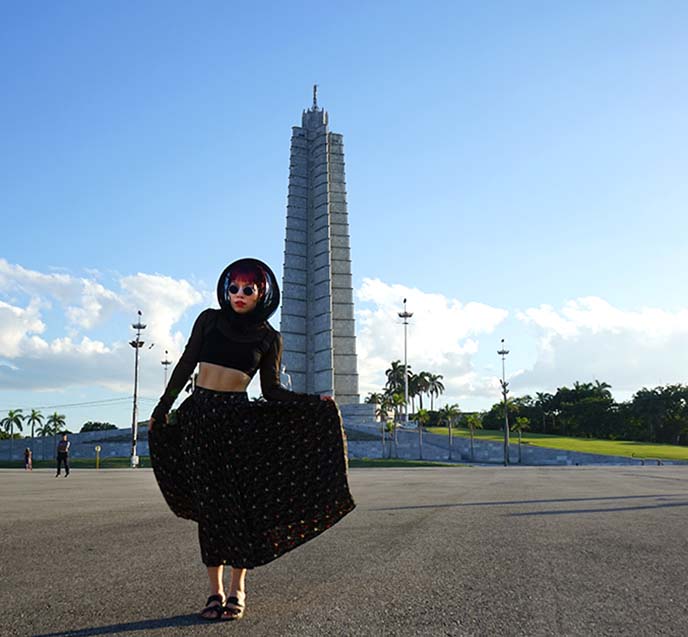
On the other side of Revolution Square rises José Martí Memorial. It’s a tribute to this 19th century national hero of Cuba, and consists of a statue of Marti, a star-shaped tower, and gardens.

Cuba has a fascinating political / cultural history that is unlike any other country (and very different from its neighbors in the Caribbean).
I was keen to learn more about the Communist takeover from a Cuban perspective, so I later visited the Museum of the Revolution (Museo de la Revolucion) in Old Havana. It’s filled with black and white photos of the leaders, and facts / records that may surprise you. I recommend it to all my fellow history buffs.

Onward to Vedado, a more modern and residential district of Havana. We drove through neighborhoods with beautiful homes, and then stopped in Havana Forest to take photos.
Outfit of the Day: Do you dig my Goth 1950s look? My hooded mesh black top is Cyberdog, my long floral skirt is from Hong Kong, and I’m wearing these exact John Lennon round sunglasses.
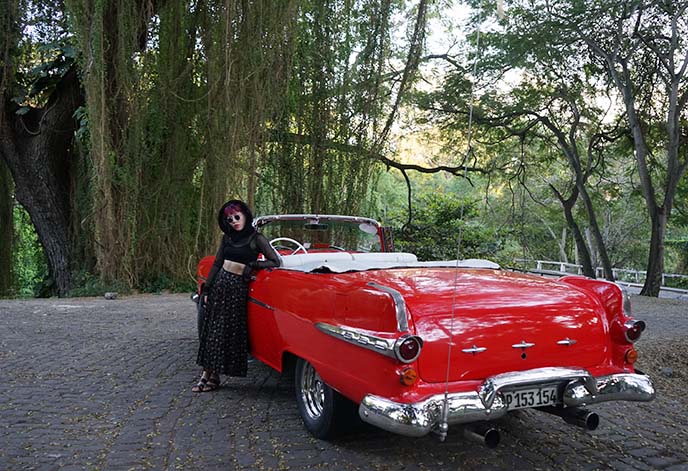
Asta and I were surprised to see this jungle area, in the middle of busy Havana! We took a moment to explore this lush park, featuring a river and waving trees.

Many Santeria practitioners come here to perform rituals in the stream, including animal sacrifices. Keep an open mind, and if you see worshipers dressed in white, don’t point a camera at them.
(There’s more on this Cuban religion further down in the post, so read on.)
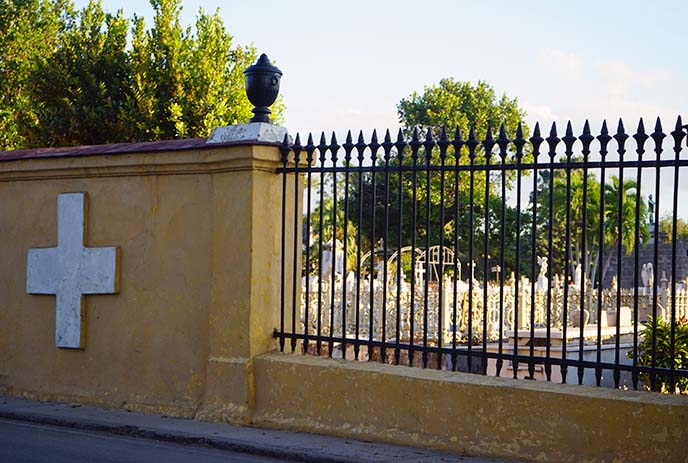
We passed by the sprawling Colon Cemetery, founded in 1876 in the Vedado neighbourhood. Named after Christopher Columbus, there are over 500 mausoleums covering 140 acres. I’ll have to come back next time to walk through this impressive graveyard, packed with white tombstones.

There’s truly no better way to get into the spirit of Cuba than by taking an old American car tour. What’s the deal with these antique vehicles everywhere?

In 1959, Fidel Castro banned foreign vehicle imports, making it impossible to purchase cars from abroad. Since then, pretty much the only wheels on the road are remnants from this era, when American expats cruised through Havana in hot rods.

Our Urban Adventures vintage car tour ended with a drive along the Malecon, as the sun was setting. We sat in the back of our cherry red convertible, and took in the soft breeze and warm light…. pure Cuba bliss.

I loved spotting cars with space-age “tail fins”, a 1950s signature. So many classic American names on the road here: Chevy, Plymouth, Buick, Ford, Oldsmobile.
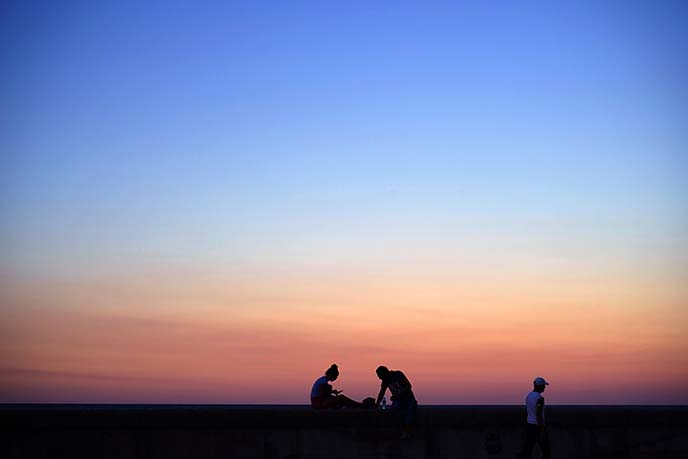
The Malecon is Cuba’s seawall, which wraps along the coast for 8 km (from Old to Central Havana, and ending in Vedado). You’ll see locals hanging out on the stone wall at all hours, but the scene is most beautiful at sunset.
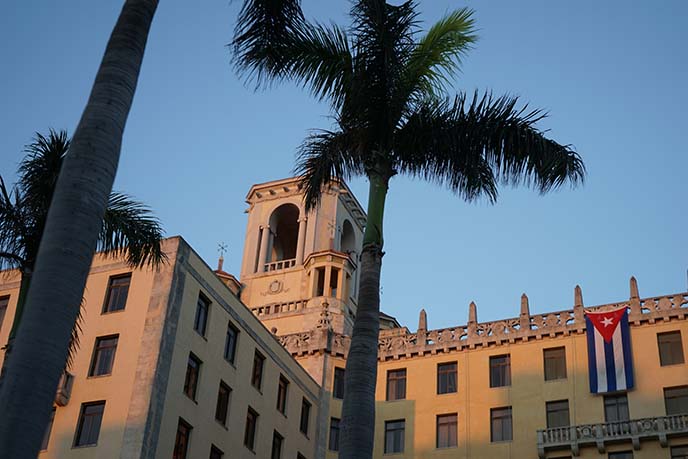
We ended the journey at The Hotel Nacional de Cuba. It’s a grand, historic hotel that was the favorite of 1930s American gangsters, famous crooners, and silver screen stars.

Inside, we looked at a display that celebrated National Hotel’s most famous guests, including Yuri Gagarin, the first human in outerspace (who met Castro in 1961, and was celebrated in Cuba). Such a cool spot to drink a Mojito and reflect on the old days.

I think these photos say it all… Urban Adventures’ vintage car tour is the sweetest way to explore the neighborhoods of Havana! More info here on how you can book a ride with them in an antique American convertible. (You can even put in a request for a specific car color.)

Asta and I loved our Urban Adventures tour so much that we did another the next day. We met guide Yanet for the Afro-Cuban religions tour, which let us explore Santeria and the local spirituality. As always, our experienced guide enabled us to get insider access to a subculture.
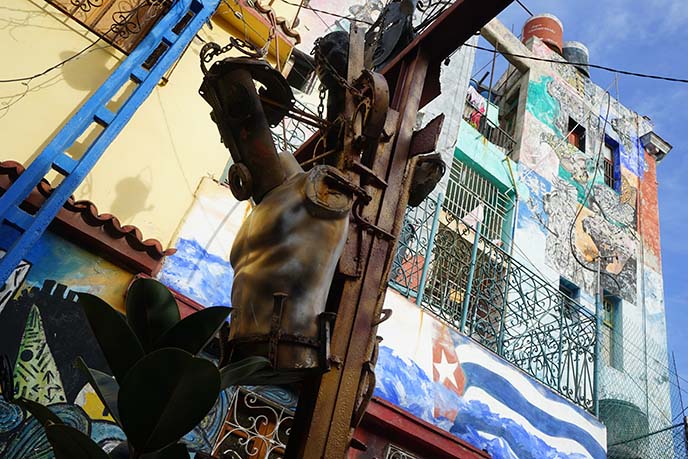
The journey takes place at Callejón de Hamel, a hub filled with alleyways of bright murals and sculptures. The artist, Salvador Gonzáles Escalona, began this project in 1990 to renew the surrounding neighborhood, and create a space for the Santeria community.

We admired the colorful paintings by Salvador, mixed in with works made from scrap objects like bathtubs, pinwheels and mechanical tools. The eclectic vibe reminded me of Philadelphia’s Magic Gardens.
I wore a rainbow-witch outfit that day. You can find many of my clothes for sale here on Depop; contact me if I can send you anything from my personal wardrobe!

Our guide, Yanet, explained the installations and spoke about the roots of Santeria. This Afro-Cuban religion has origins in the native spirituality of Africa, and became syncretized with Catholicism during colonial times (when slaves were brought to the New World).
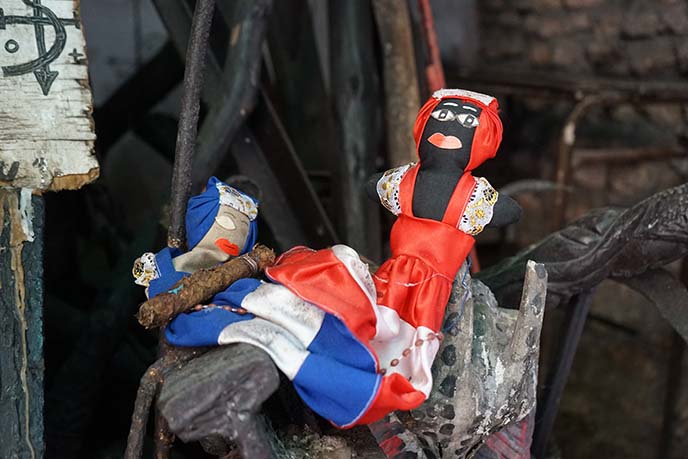
Cuba’s spiritual practices are a mix of local customs, folklore, and beliefs from various sources. Some people mistakenly associate Santeria with voodoo, but these two are very different (voudou is a syncretic religion practiced mainly in Haiti.)

Callejon de Hamel is free for anyone to visit. It’s hard to imagine that this once was a sketchy, desolate area: Salvador has transformed it into an inviting, positive space. You can often catch musicians and rumba dancers performing in these alleys.
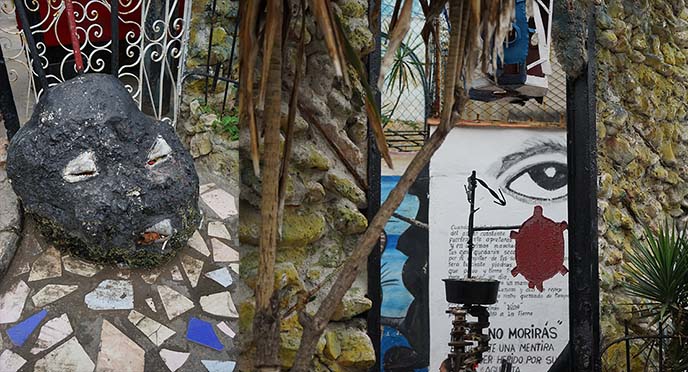
Yanet taught us about the orishas, or gods of the Santeria pantheon. One of my favorites is Elegua (on the left), represented as a playful child or old man. Visitors leave Cuban cigars in his mouth to keep this trickster happy.

There’s also a god of war (Changó), goddess of love (Oshún), a mother figure (Yemayá), a hunter (Ochosi), healer (Babalú Ayé) and more.

Santeria translates to “worship of the saints,” as there is a creator god and a number of lesser deities. These orishas rule over various aspects of human nature and endeavor, and you can call upon them depending on your particular situation.

When the colonialists shipped Africans to the Caribbean to work as slaves, they also baptized them as Catholics and banned their tribal faiths. However, the Africans still worshiped their orishas in secret, by associating them with Christian saints like St. Christopher. Santeria therefore developed as a unique syncretism.

We met a babalawo, or priest. His role is to be a spiritual adviser, and help people in various ways — including by fortune-telling with the tossing of shells.
Urban Adventures has special permission to enter the home of Salvador (the artist) and his family. We got to see their personal shrines to the orishas, where they make offerings of food, and bow in a way that touches each elbow to the ground.
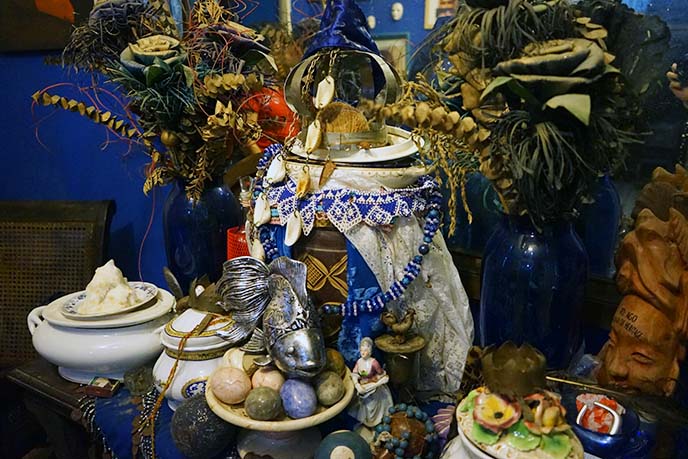
In Santeria, each practitioner is associated with one protector deity (which you determine through ritual and the advice of the babalawo). This family member’s orisha is Yemaya, the fierce mother of the seas — hence the blue decorations, shells, fish and other objects related to her.
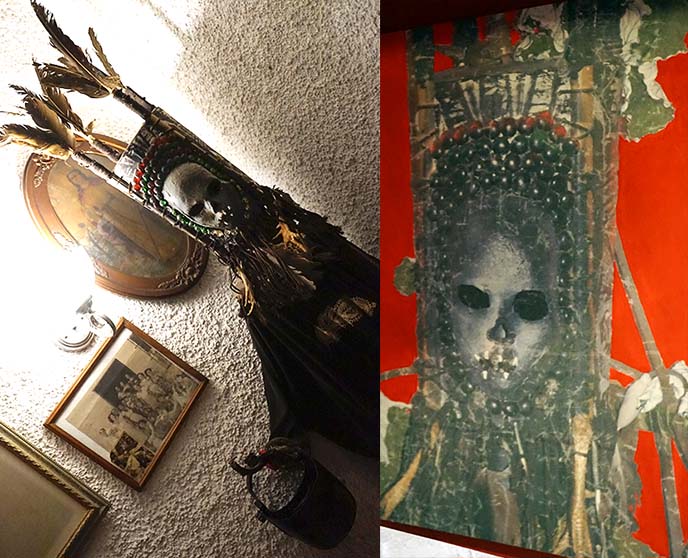
These personal shrines stay with them their entire lives. When Iku (the deity of death) arrives, the babalawo consults the spirits to find out what to do with the objects (burn them, bury them, etc).
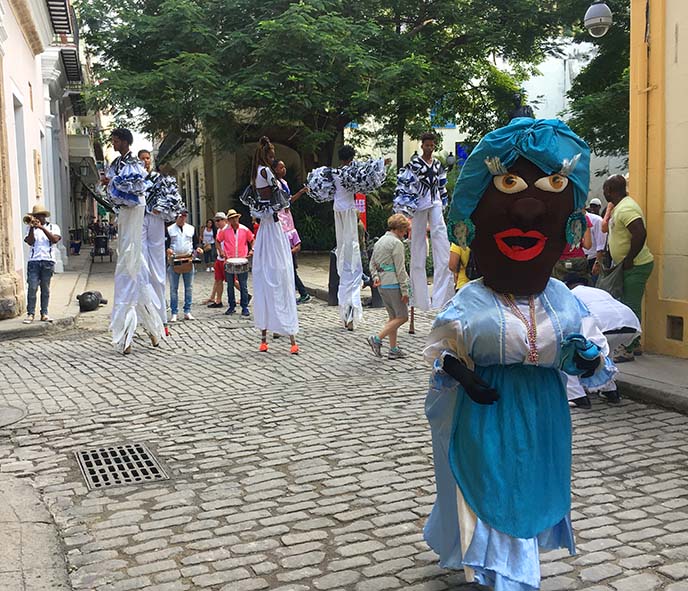
We loved learning about Cuban spirituality and culture up-close. If you simply walk through the streets of Old Havana, you’ll come across colorful aspects — like this costumed parade of stilt-walkers.
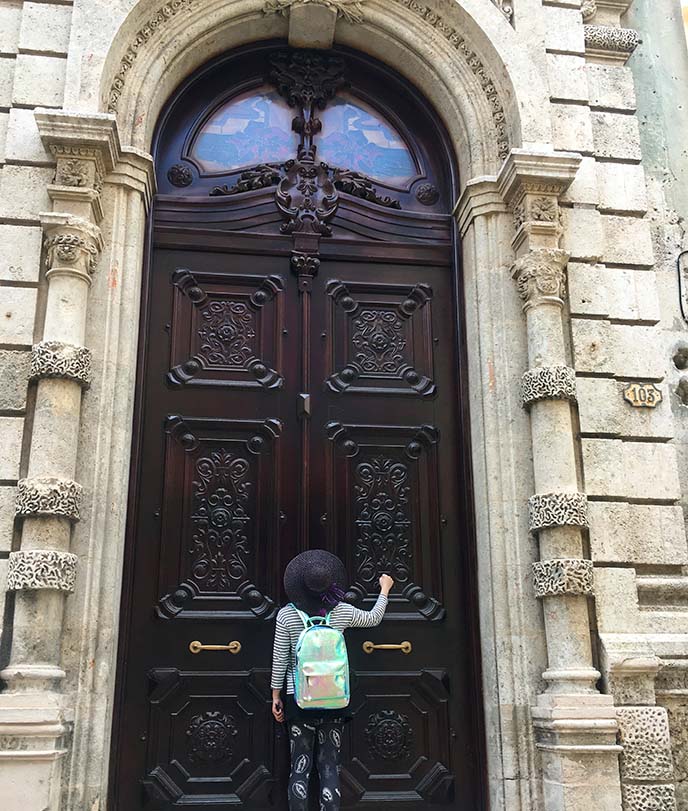
The colonial legacy is everywhere to be seen, especially in the dramatic architecture and tall doorways.

Havana is a safe city, and “chill” is the best word to describe the residents. You’ll see locals hanging out on doorsteps, and chatting with their neighbors.
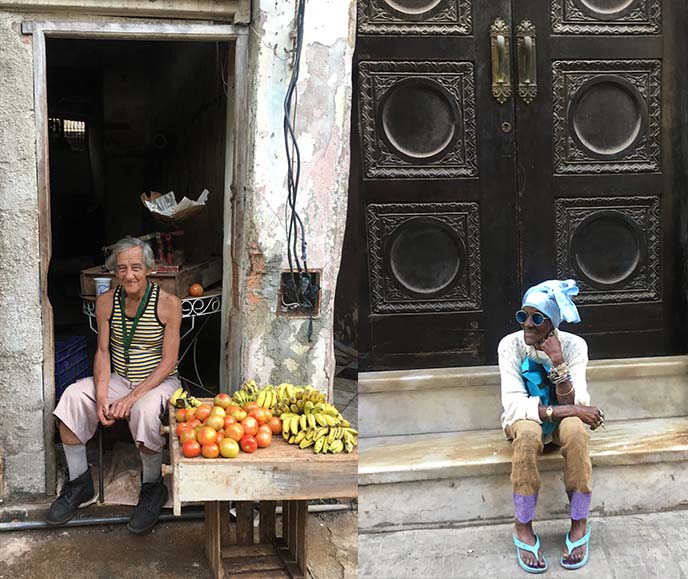
Headwraps and bright clothing are a common sight.
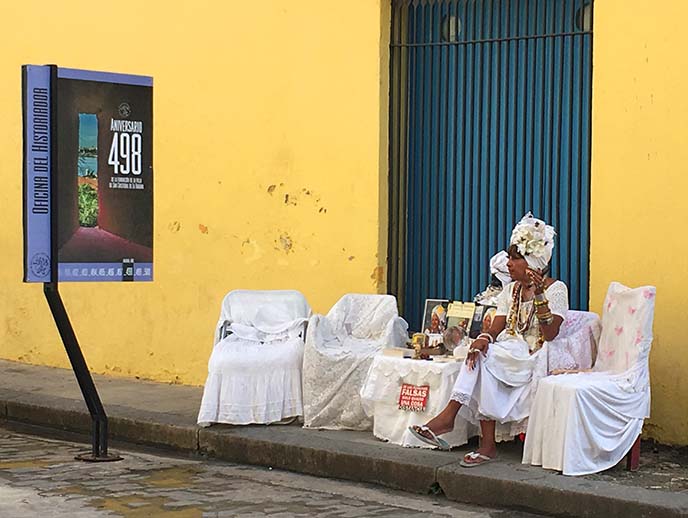
I came across a fortune teller, clad in white and with strands of beads draped around her neck.

Havana is also associated with author Ernest Hemingway, who lived here from about 1940-60. Many tourists visit his favorite bars, La Floridita and La Bodeguita del Medio, where he drank daiquiris and mojitos. (I didn’t visit, as I was more interested in seeing the romantic gardens all around Havana.)

We ran into more street art by Yulier Rodriguez. His provocative, signature style is unmistakable.

How fitting to find a motorcycle, in front of this mural of Che Guevara! When he was a young medical student, Che rode 5000 miles through South America (as documented in his book “The Motorcycle Diaries.”) The journey opened his eyes, and stirred his dream of seeing a united Latin America.
On the right, we see “Estudio, Trabajo, Fusil” (Study, Work, Rifle), the motto of Cuba’s Communist Youth Union.

It was interesting to learn the Cuban point-of-view of historical events and figures. They highlighted achievements such as the excellent medical and educational system, which is open to all Cubans regardless of their income.

Without doubt, Havana is a city of music and color! Where else can you pay 2 CUC ($2) for a mojito, and enjoy an energetic rumba?

These silly boys welcomed us back to our casa particular, Prado Colonial. I’m all about supporting small local businesses, and staying with a casa is one of the easiest ways to do so. (More info and photos of our hotel here.)

Gracias Havana Urban Adventures for making my “greased lightning” goals a reality! If only I could take this classic auto home as a souvenir…
Have you been to Cuba? Planning a trip? Feel free to leave a comment if I can help you with travel tips, and I’ll gladly reply.
SHARE & COMMENT
Visiting Dracula’s Bran Castle: Vampire tour of Transylvania! Vlad the Impaler, Romania Goth Halloween.

“My friend. Welcome to the Carpathians. I am anxiously expecting you.” – Count Dracula’s invitation to Jonathan Harker, in the Bram Stoker novel.
Last Halloween, I got to live out my vampire dreams (or nightmares)… at Dracula’s castle in Transylvania!
With the support of Experience Romania, I got to come and learn about the real Vlad Dracul, a ruler whose history is wrapped up in horror mythology.

For years, I had the “Goth goal” of visiting Bran Castle in Brasov, Romania. This dark fortress is associated with the bloody tales of Vlad the Impaler.
I wore my Moi-meme-Moitie dress; the silhouette and design are straight out of Nosferatu. This is an Japanese Elegant Gothic Lolita design by Mana, who you may know from the Visual Kei bands Moi-dix-mois and Malice Mizer.

Keep reading for an exclusive look inside Bran Castle, including photography in areas that tourists aren’t able to access. We’ll wind up in a torture garden, and get to know the Romanian vampire. (All photos by Joey Wong.)
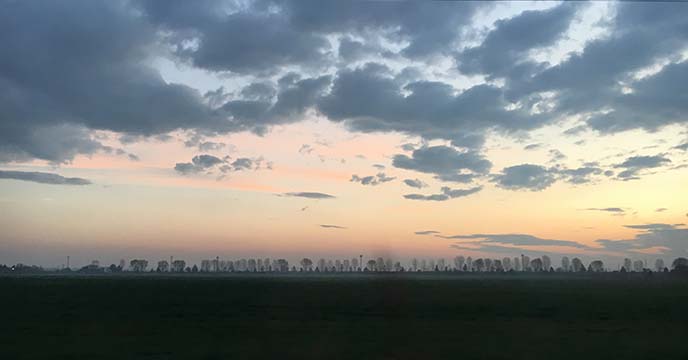
As you may remember, I was invited to Experience Bucharest around Halloween 2017. On one of our free days, photographer Joey Wong and I met up with our local Romanian friends, Alex and Beatrice. They kindly drove us from Bucharest to Bran Castle in the early morning.
(To get to Dracula’s castle, it’s also possible to take the train, but there are limited departure/arrival times. You can also rent a car, or hire a private driver for the trip).
When you see the dawn breaking over the misty landscape, it’s easy to understand why Romania is the land of vampire tales.

The drive from Bucharest to Brasov is a beautiful one, especially in fall when the leaves have Halloween hues. If you’re based in Bucharest, this is a perfect day trip to Transylvania. (You can also stay overnight in Brasov, if you want to spend more time in the region).
The journey to Bran Castle takes about 3-4 hours by car, depending on traffic (it’s a good idea to leave early, in case you get stuck). On the way back in the afternoon, the ride took longer.

As we got closer, the roads became windy, and the Carpathian mountains loomed over us.
The Carpathians are a mountainous range through Central and Eastern Europe, with the largest portion in Romania. These dramatic hills are home to brown bears, wolves, lynx… and maybe some blood-sucking bats?

Transylvania is the central region of Romania, located north of Bucharest. Its high-contrast clouds and craggy mountains looked straight out of a horror movie. When we saw these horses under an ominous sign… we knew we must be getting closer.
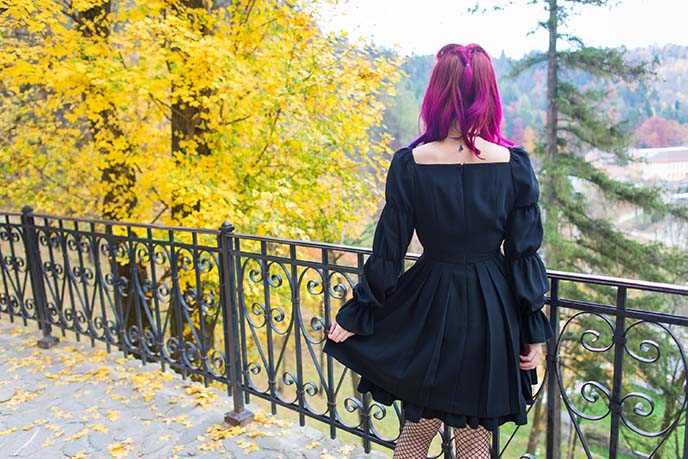
At last, we made it to Bran Castle! On their website, you can find access, admission and visitor info. When we arrived, there was a line up for tickets, which cost about 7 euro (there are senior and student discounts). Bran Castle kindly welcomed us as press, giving us permission to photograph usually-restricted areas.
Dracula Castle address: Strada General Traian Moșoiu 24, Bran 507025, Romania

Visitors have to first walk up a steep path to the castle, lined by dark gravestones like this one. Do Dracula’s remains lie beneath the soil?
Not quite. In fact, Bran Castle is only loosely connected to the historic Vlad the Impaler, who may have never even stepped foot here. Keep in mind that ever since the publication of Bram Stoker’s “Dracula” novel, the man and myth have blurred in the public imagination. This castle is located in Transylvania (where the fictional Count lived), and has an appropriately imposing, Medieval look… what better setting to dive deep into the bloody legends?

Inside, you’ll find portraits and historical information about Vlad III, also known as Vlad Tepes or Vlad Dracula. In real life, he was the second son of Vlad Dracul, the 15th century prince of Wallachia, Romania. Records show that he signed two of his letters “Dragulya” or “Drakulya” — which means “the son of Dracul.”
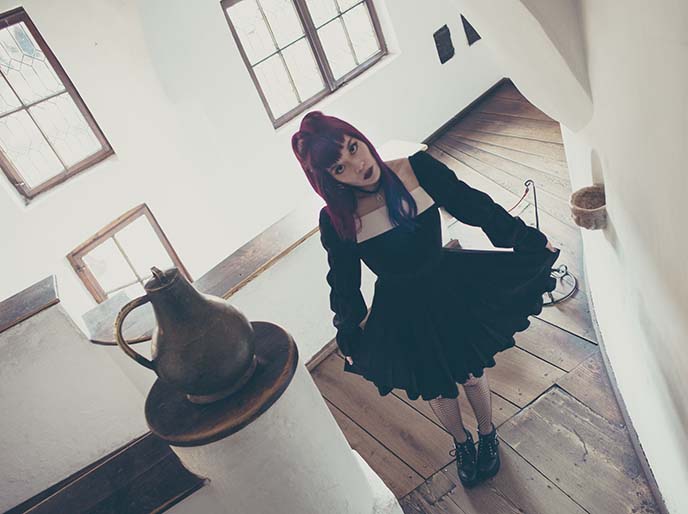
Vlad actually lived in Wallachia, the area south of Transylvania. In the late 14th century, a group of German colonists built Bran Castle in Brasov (where I’m standing). Their descendants may have wound up as Vlad’s victims, during his reign.

Although Bran castle wasn’t the primary home of Vlad, it has the “Dracula” feeling conjured by the novel and other vampire works (films, comics, you name it).
Author Bram Stoker never even went to Romania before writing his book. He based Count Dracula’s castle on Whitby Abbey in England, which I also visited.

Vlad was called “The Impaler” by the Ottomans, and was also known as the Butcher or Demon. What’s the deal with the nickname?
As the castle banners indicate, impalement was Vlad’s favorite method of execution — spearing bodies on a stake, and leaving them to die. He executed thousands in this manner, and even created a “Forest of the Impaled” with 20,000 pierced bodies. Some say Vlad enjoyed dining with his palace associates, surrounded by a circle of impaled victims.
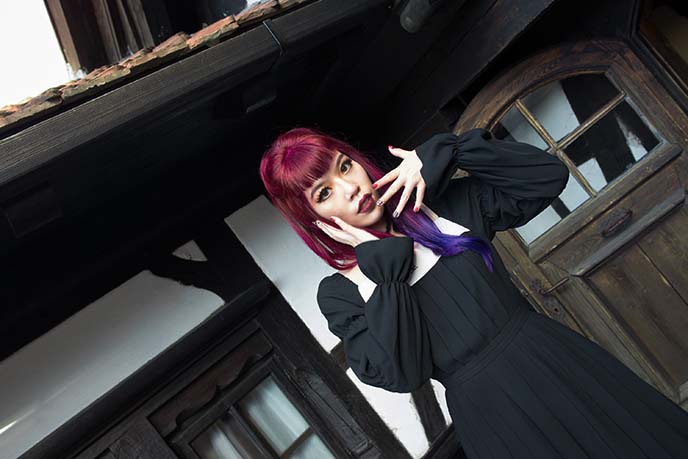
Vlad is usually depicted as a villain, but there’s another side to the story. Many Romanians consider him a hero, and one of the country’s greatest rulers.

It’s important to understand the context of Vlad’s actions. As a youth, he was imprisoned by the Ottomans, and severely abused. When he took reign, his harsh punishments were a way to strengthen the central government from dissenters. Some historians interpret his cruelty as rational acts to secure the independence of Romania, as the land was surrounded by the much stronger Turks.
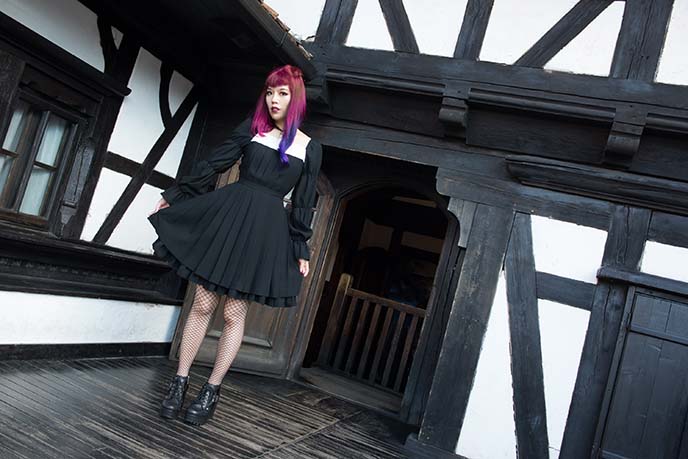
During his reign, Vlad actually lived in Poenari Castle, a cliff-side citadel in Wallachia. You have to climb 1,480 concrete stairs to reach the top. Poenari castle is located quite a bit further from Bucharest, so I’ll have to wait until next time to visit.

Vlad the Impaler was possibly imprisoned inside Bran Castle for a few months; he was exiled and jailed multiple times during his three reigning periods. Regardless, the Transylvanian castle is sensational, and makes you feel as if you’re a character in the Dracula story.
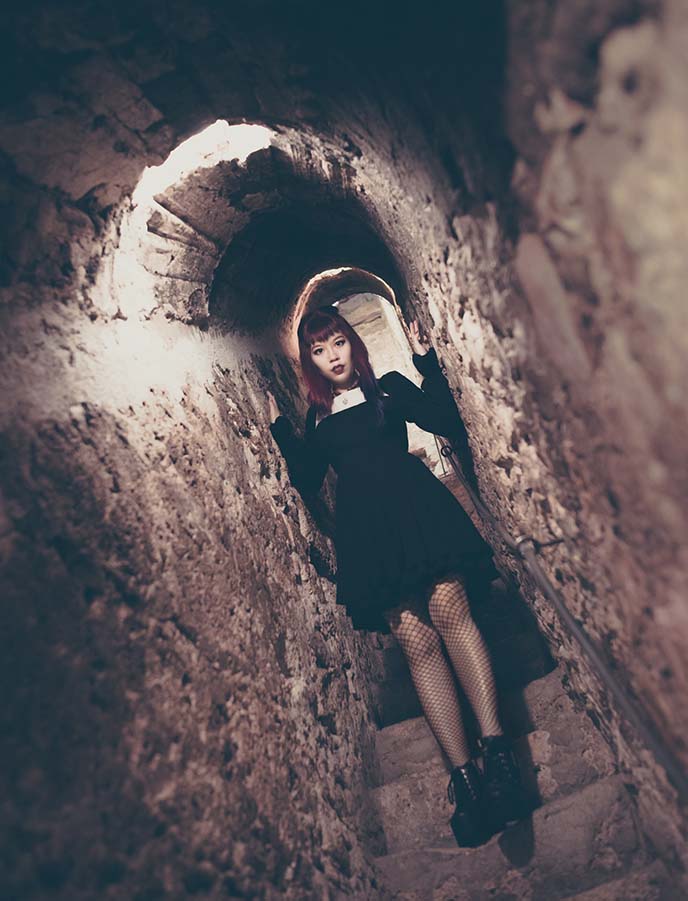
What dark secrets hide within these walls? Perhaps a crypt lined with coffins?
Bran Castle does have a system of secret tunnels, which weren’t discovered until later. These narrow, steep passages were built as escape routes. On regular tours, you aren’t able to go inside… but this vampire got special permission.

In 1920, Bran Castle came into the possession of Queen Maria, the last queen of Romania. In 2009, it became open to the public as a museum and attraction. Inside the castle, you can see relics of her royal residence, including art and furniture from her personal collection.

No wonder Queen Maria made this her special residence. The castle architecture is captivating, with winding staircases and picture windows.

On the upper levels, you can learn about Vlad and the folk tales that inspired vampire legends. My Romanian friend Alex found his ancestor on the family tree… proof of his vampire bloodline!
I read about “strigoi,” the evil souls of the dead that kill victims by sucking their blood, and have the ability to transform into animals (forming the inspiration for modern vampire tales). If pregnant women drink cursed water or go outside without covering their heads, then Satan puts a red bonnet on them and their newborns. Unless it’s removed, the babies will transform into “strigoi” — the undead that live among us.

The sunlight… it burns, it burns!
Standing inside Dracula’s Castle, I realized how much the legend has inspired fashion, art and pop culture — from Lost Souls, to Interview with the Vampire, to Buffy.
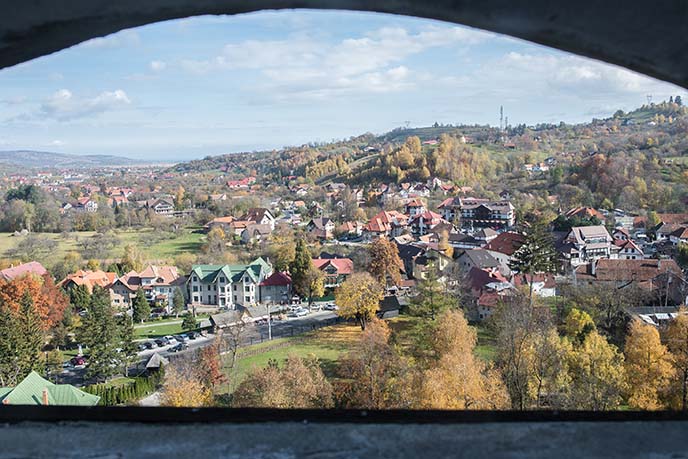
Through this arched window, I looked out at Transylvania. Bram Stoker’s 1897 novel turned the region into a household name associated with vampires. With a landscape like this, no wonder this is perceived as a magical, mysterious and dramatic land.
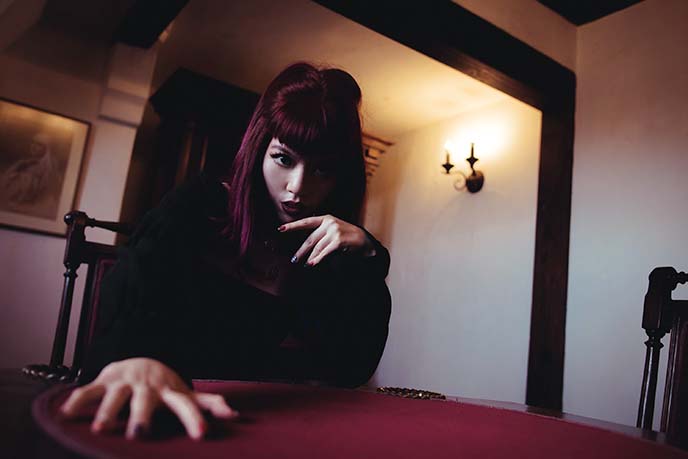
Similarly, we’ve all heard of the word “Nosferatu,” which refers to The Devil in modern Romanian. Photographer Joey Wong captures the spirit in this image.

Can you see my reflection in the mirror? I didn’t stumble across any coffins in Bran Castle, but the entire castle had a haunted feeling (creepy nooks, squeaky staircases, four-poster beds straight out of Dracula movies).

When night falls… it’s not difficult to imagine “strigoi” flying out from these woods!

Bran Castle also hosts rotating exhibitions. When we visited, there was a collection of torture devices used in the Middle Ages.
I felt genuinely scared, standing inside this iron maiden lined with deadly spikes. The lady’s evil smile makes matters more frightening.

I’m pointing at Vlad the Impaler’s favorite instrument. Sometimes, the stake was sharp and killed victims quickly. Other times, it was dulled and oiled, and went through the body in a way that didn’t pierce the heart — prolonging the pain and duration.

I shudder to think of what it was like, living in the time of these torture devices.

What a treat to visit Castle Bran and immerse myself in the world of Vlad the Impaler. Even though it’s technically not “his castle,” I loved the sinister experience and Transylvanian setting.

I leave you with some Romanian vampire souvenirs. I took these photos at Bucharest’s Henri Coandă airport; you’ll find a huge selection of Dracula-themed red wines in the shopping area before departures. I wish I could have bought them all… but I had no room in my suitcase.

In addition, there’s a selection of vampiric liqueurs. Who needs tequila when you can drink Draquila?
I was intrigued by Potion of Dracula, a plum brandy or “palinka” that hails from Transylvania. The 40% proof liqueur is packaged in what looks like a magic flask, with an antique lock and keey.

Don’t you think the 555 should be 666? I didn’t have the opportunity to try any of these Count Dracula wines, but I did enjoy the Romanian red that I had at an Experience Bucharest networking event.

I was tempted to pick up these cute magnets and keychains, which I found at a rest-stop during our roadtrip from Bucharest to Dracula’s Castle.

How do Romanians feel about being associated with vampires? It’s a mixed bag, but many of them embrace the Vlad Draculea “bloodline” and its impact on pop culture.
Most of the airport’s souvenirs had a vampire theme, including stuffed toys and “Vladut’s Story” plums in chocolate cream. There was even a plush of Tim Curry’s character in The Rocky Horror Picture Show, who hails from”Transsexual Transylvania!”

I guess he’s Count Chocola for a reason… quite a few of the Dracula gifts were chocolates. Love the coffin figure as well.

A million thank yous to Experience Romania for the best Halloween ever. I loved exploring the country, and am dying to come back and see more.

Whether he’s a folk hero or fanged horror villian, Dracula has captured the imagination of millions worldwide. At Bran Castle, you get to become part of the legend.
So I leave you with a quote by Bram Stoker’s Count: “Once again…welcome to my house. Come freely. Go safely; and leave something of the happiness you bring.”
(And if you’re hungry for more bloody tales, here are all my travel posts about Bucharest and Romania!)

 LA CARMINA
LA CARMINA






